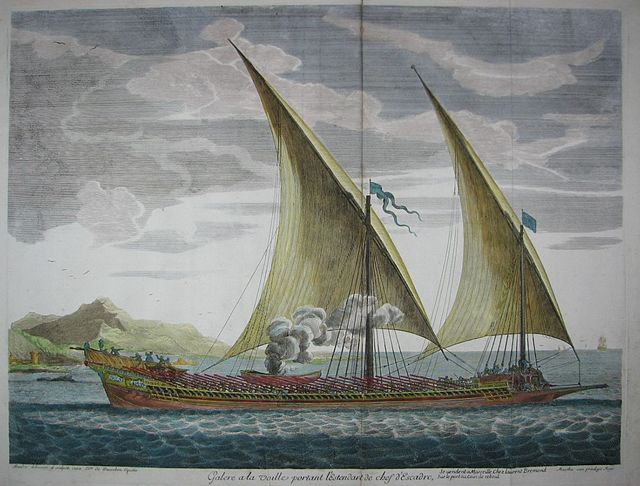Galley slave
Videos
Page
A galley slave was a slave rowing in a galley, either a convicted criminal sentenced to work at the oar, or a kind of human chattel, sometimes a prisoner of war, assigned to the duty of rowing.

Diorama of convicts on galley benches at the Museu Maritim, Barcelona

A painting of the 1571 Battle of Lepanto in the Ionian Sea, where both sides relied on tens of thousands of slaves, prisoners or convicts as oarsmen.

A réale galley belonging to the Mediterranean fleet of Louis XIV, the largest galley force of the late 17th century; oil on canvas, c. 1694
Galley
Videos
Page
A galley was a type of ship which relied mostly on oars for propulsion that was used for warfare, trade, and piracy mostly in the seas surrounding Europe. It developed in the Mediterranean world during antiquity and continued to exist in various forms until the early 19th century. It typically had a long, slender hull, shallow draft, and often a low freeboard. Most types of galleys also had sails that could be used in favourable winds, but they relied primarily on oars to move independently of winds and currents. The term "galley" originated from a Greek term for a small type of galley and came in use in English from about 1300. It has occasionally been used for unrelated vessels with similar military functions as galley but which were not Mediterranean in origin, such as medieval Scandinavian longships, 16th-century Acehnese ghalis and 18th-century North American gunboats.

Colourised engraving of a French galley (27 pairs of oars) built according to the design that was standard in the Mediterranean from the early 17th century; Henri Sbonski de Passebon, 1690

United States ships at the Battle of Valcour Island depicting several "row galleys" similar in function but based on very different designs from Mediterranean galleys; watercolor by Charles Randle

Drawing of warships (pointed bows) and trade ships (rounded bows); based on a wall relief from the Southwest Palace at Nineveh, circa 700 BC.

Two compact liburnians used by the Romans in the campaigns against the Dacians in the early 2nd century AD; relief from Trajan's Column, c. 113 AD